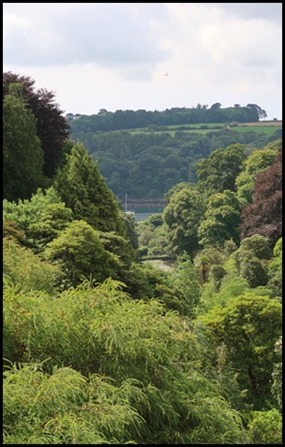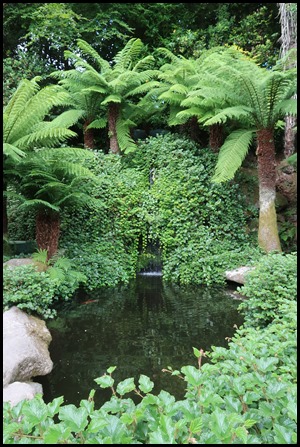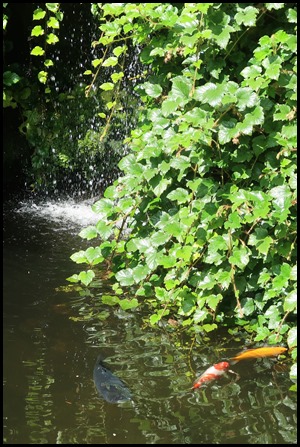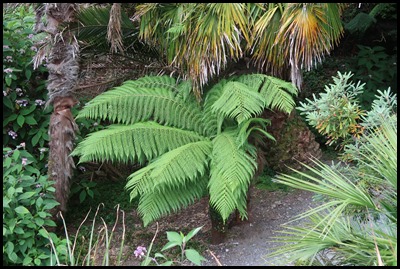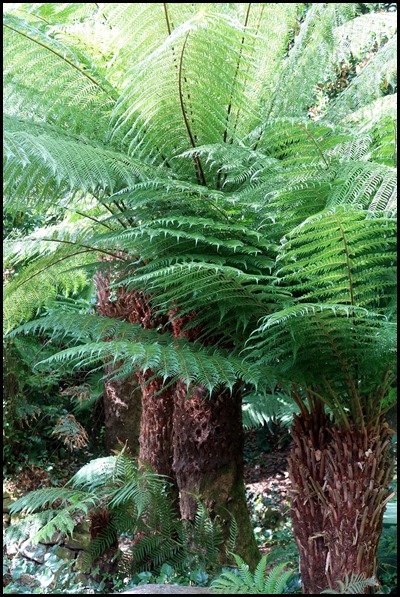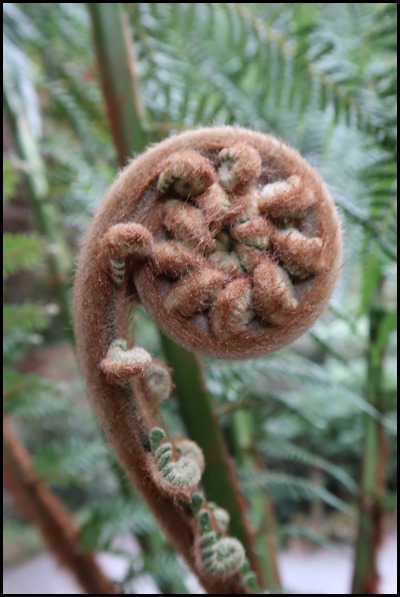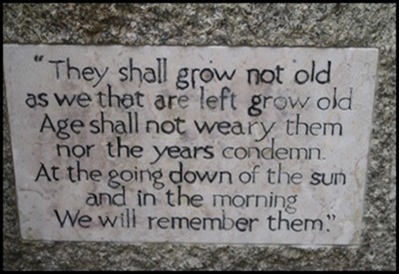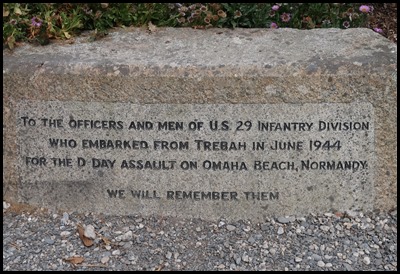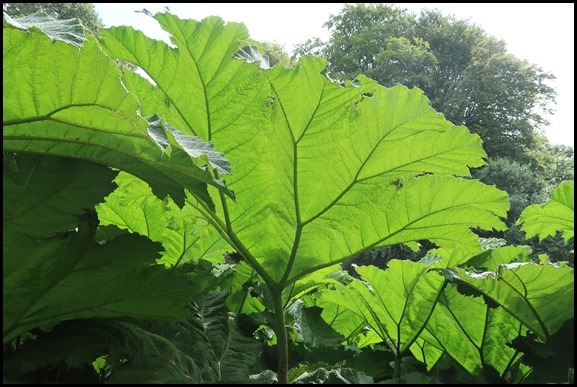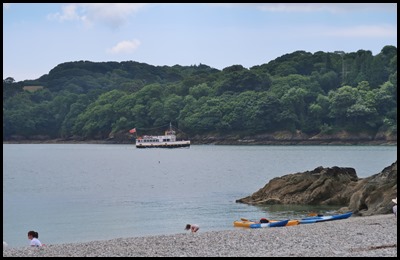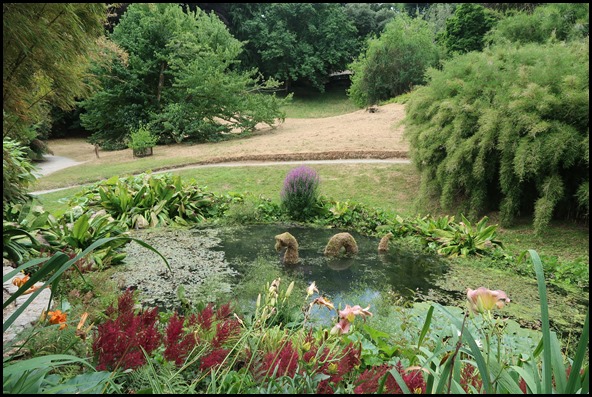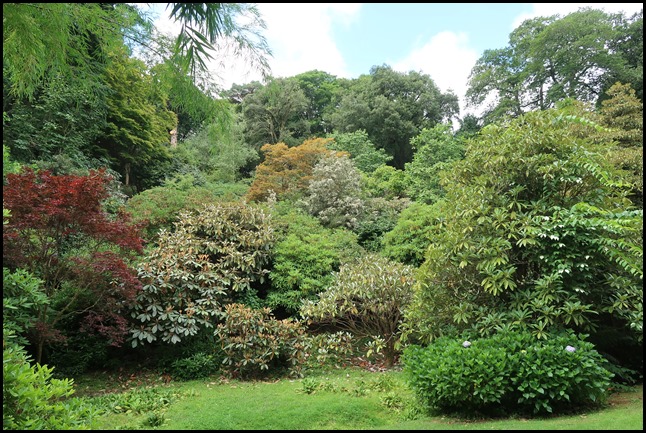Trebah History

|
Trebah Garden
History  Martin and Cecily took us to Trebah
Garden and when I asked the lovely lady at the counter if I could type out the
information on the free flyer she told me to copy the information from the very
informative website. So I did. Thank you Trebah.
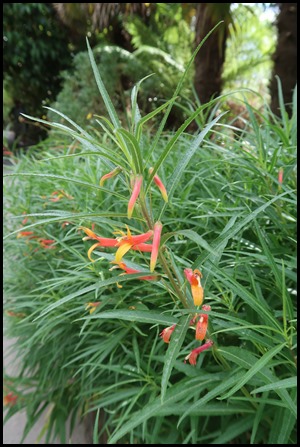   In the Beginning.
The first historical reference to Trebah is found within the Doomsday Book of
1086 and was the property of the Bishop of Exeter. The name ‘Trebah’ is thought
to derive from the Celtic ‘Tre-Baya ’ meaning ‘House on the Bay’, and would
suggest there may well have been a dwelling nearby. For the next 745 years it
was passed between members of Cornish families until 1838 when the house and
garden, plus Polgwidden Cove at the foot of the valley was acquired by Charles
Fox for £4,375 from the Nicholls family.
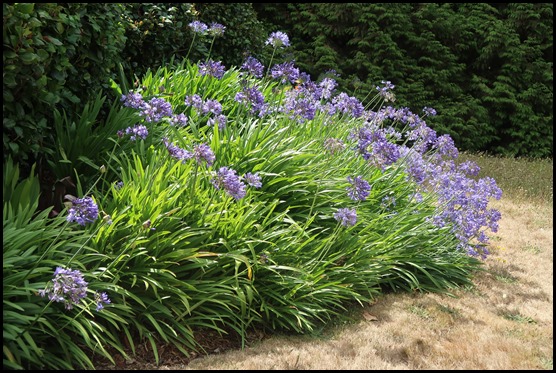
The Fox Family. Charles Fox was a member of a large wealthy Quaker family who had been settled in Cornwall since the seventeenth century. They ran a shipping business, had a large interest in the famous Perran Foundry, in the tin mines and in pilchard fishing. The Foxes were foremost in any project that helped the citizens of Falmouth, giving generously not only of their money but their time and energies. They were an extraordinary family, creating with horticultural zeal at least six gardens in southwest Cornwall including Penjerrick, Glendurgan, Rosehill and Trebah and stocking them with exotic plants – many of which had never been grown in Britain before. Being shipping agents, they were well placed to arrange transportation of exotic plants from warm temperate regions of the world, to their gardens in Cornwall. During the late 1830s and early 1840s Charles Fox prepared Trebah in readiness for the first batch of plants to arrive. In the field on either side of the valley, he planted hundreds of Monterey Pine Pinus radiata, Maritime Pine Pinus pinaster and Holm Oak Quercus ilex to act as a shelterbelt against the worst of the elements. As a second line of defence, he planted green and purple-leaved beech Fagus sylvatica and F. sylvatica ‘Purpurea’ on the valley sides. Many of these trees are still standing today. Charles Fox paid meticulous attention to the exact positioning of every tree. He instructed his Head Gardener to build a scaffold tower to represent the eventual height of each tree; the youngest garden boy was then sent up the tower with a flag. From an attic window and armed with megaphone and telescope, Charles would direct movements until the perfect planting spot was attained. In 1856/57 a fine Victorian house was built immediately to the east of the Nicholl’s house, which was then used as servants quarters.
The Backhouses. Charles’ daughter Juliet married Edmund Backhouse MP and inherited Trebah on Charles’ death in 1876. The ensuing 30 years of Backhouse ownership was a golden era for Trebah during which it acquired a huge collection of exotic plants and trees from all over the world. In 1880 they took delivery of 300 Tree Ferns Dicksonia antarctica, part of a consignment of 3000 shipped over from New South Wales. They were off-loaded onto the Falmouth quayside and shared out between ten of the best gardens in Cornwall. By the end of the 19th century the gardens at Trebah were beginning to resemble much of what we see around us today. The main paths had been made up with gravel from the shore and laid out, pools were dug out along the stream running through the valley and literally hundreds of plants were introduced from all corners of the world. It is interesting to note that many tender shrubs and plants such as Bougainvillea speciosa, Cassia corymbosa, Myoporum laetum and even the ivy-leafed Pelargonium ‘Madame Crousse’ thrived and featured prominently at that time. An early inventory includes Asian and American conifers such as the West Himalayan Spruce, Picea smithiana, Chinese Fir Cunninghamia lanceolata, Arizona Cypress, Cupressus arizonica, the Hoop-pine of Australia, Araucaria cunninghamia, Chinese bamboos including Phyllostachys quiloi and of course, rhododendrons in profusion. Cornwall had become the first ‘port of call’ for new rhododendron introductions, collected from afar by great Victorian plant collectors such as Sir Joseph Hooker. Hooker was a great friend of Charles Fox’s brother Robert, who was creating the gardens at Penjerrick and so it is assumed that many of Trebah’s early rhododendrons came from this connection. Some rare rhododendrons were also propagated, notably, R. ‘Trebah Gem’ (it is the result of a cross between R. arboreum ssp. arboreum and R. griffithianum) which is said to have been planted in 1900 by the Head Gardener, Harry Thomas and is still growing in Rhododendron Valley; R.’Trebianum’ and R.’Edmundii’ (named after Sir Edmund Backhouse)
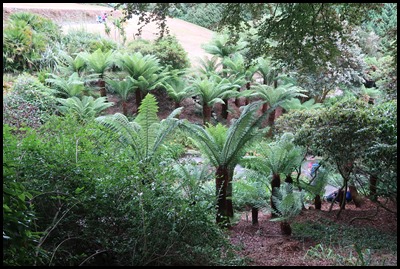
The Hexts. In 1907 Charles Hawkins and Alice Hext bought Trebah. Charles died in 1917 but until the outbreak of the Second World War the garden continued to be developed by Alice and the diversity of the plant collection continued to expand. The marshy area at the bottom of the valley was puddled to create what has subsequently become known as Mallard Pond and stocked with pink flamingos, a boathouse was built and a open fronted, thatched roof and cob walled summer house was built on the eastern side of the garden. Notable plants at Trebah during this era recorded by Edgar Thurston in his publication British and Foreign Trees and Shrubs in Cornwall included Acacia dealbata (15m), Banksia verticillata (15m), Metrosideros robusta and Grevillea asplenifolia. Alice Hext was a noted benefactor to the County and local parishes, she often opened the garden to the public and it was used for fetes and garden parties. Amongst the many visitors at this time was the Prince of Wales, who with Wallis and Ernest Simpson was shown round the garden in 1935. At the Prince’s request, Alice sent him some plants of Chatham Island Forget-Me-Not, which he had admired, for the gardens at Sandringham. Alice died in 1939, drawing this era to an end and the estate was inherited by a niece, who sold the farm and house separately.
The War Years. During the years of the Second World War, Head Gardener Robert Day and a reduced staff little more than maintained the gardens. The beach was concreted and the boathouse and rocks were dynamited to allow access for tanks. The garden was used as an ammunition store, and trenches dug in the lower part of the garden. On 1 June 1944 a regiment of 7,500 men of the 29 US Infantry Division with their tanks, guns and transport embarked from Trebah Beach in ten 150-foot flat-bottomed landing craft. For five days they battled through enormous seas to the Isle of Wight and then on to the D-Day assault landing on Omaha Beach in Normandy, where they suffered grievous casualties. A memorial at the bottom of the garden commemorates the courage of these brave young American soldiers.
1946 – 1952. The garden changed hands twice in this short period, and in 1947, during repairs to the roof, the main house caught fire and was destroyed, leaving only the original Georgian house at the head of the valley. Also, at about this time the remaining moor was ploughed, drained and planted with blue hydrangeas. A consignment of plants were received from Tresco Abbey Gardens in 1950 which included many rare southern hemisphere plants such as Anopterus glandulosus, Psoralia pinnata, Banksia serrata and Acacia pycnantha. In 1951 Mr Harold Hillier visited the gardens in exchange for mature specimen tree ferns and Gunnera manicata, and other plants which he required for the Festival of Britain at Battersea Park, and he sent many plants to Trebah in return.
The Fords. Freddie Ford and his family lived at Trebah for nine years and made a business from the garden sending cut-foliage and flowers to Covent Garden. Mr Ford retained Jon Petrichenko, who had worked at Trebah since the war, as his Head Gardener, and he carried on with further development and maintenance. An Estonian by birth he had escaped conscription to the Russian army and made his way across Europe to England. In 1959 Alan Mitchell visited Trebah and recorded the measurements of a number of the more important trees. At that time a Pinus radiata was recorded as the tallest example in Britain, Cunninghamia lanceolata had attained 24m and Podocarpus totara (16m) was described as outstanding.
The Healeys. In 1961 Trebah was bought by the racing driver and car designer Donald Healey who used some of the outbuildings to carry out development work on his Healey cars. He built the first of the three Rolls Royce engined prototypes there as well as the running chassis for the prototype Jensen-Healey. Over the next ten years he removed much of the concrete from the beach with a grant from the War Department, built the boathouse with granite, which had been used as hardcore on the beach, restored the ponds and constructed orchid houses near to the house where they cultivated Cymbidium orchids. The Healeys planted the camellias glade for cut blooms for the London market and also dispatched hydrangeas, agapanthus, belladonna lilies, eucomis and helleborus by rail two or three times a week. Eventually it was felt that Trebah was too large a commitment for the Healeys. The cut-flower market, which had previously covered the costs of the gardeners and the overheads, had become less profitable, and this together with family reasons led to the decision to sell and move to Truro. There is a memorial to Donald Healey on the right as you step out of the Hibbert Centre.
1971 to 1980. Trebah was to have two further owners in the next ten years, during which time gales struck Cornwall and 47 trees were torn down including significant specimens from Alan Mitchell’s recordings of 1959.
The Hibberts. Major Tony and Eira Hibbert bought Trebah as their retirement home on their 64th birthday in 1981. They were persuaded by the Secretary of the Cornwall Garden Society to begin a programme of work to restore the garden that had been regarded as one of England’s most beautiful and important earlier on that century. Over 30 years later, the garden is undeniably once again one of the most beautiful gardens in Cornwall, if not Britain. They opened the garden to the public in 1987 to help pay for the cost of upkeep and by 1989 visitor numbers had reached 36,000. The Hibbert family then gave the house, garden and cottages to the Trebah Garden Trust, a registered charity with trustees who oversee the management of Trebah. Their sole objective is to ensure that this remarkable garden will be preserved and maintained for the pleasure of future generations.
ALL IN ALL A STUNNING GARDEN BEAUTIFUL |
